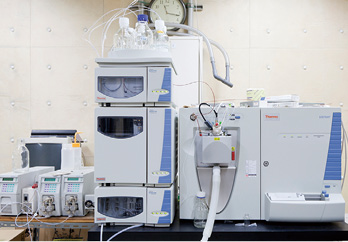
As of August, 2015
| Faculty/Department | Department of Engineering Science Graduate School of Informatics and Engineering |

|
| Members | Shojiro Maki, Associate Professor | |
| Affiliations | American Chemical Society; Electrochemical Society (USA); Organic Electrochemistry Group of the Electrochemical Society of Japan; Chemical Society of Japan; Japan Society Engineering Managers for Waste Disposal Facilities; the Pharmaceutical Society of Japan; The Society of Synthetic Organic Chemistry, Japan | |
| Website | https://sites.google.com/gl.cc.uec.ac.jp/hiranomakilab | |
RGB three primary color emission; Aka Lumine®; chemiluminescence; bio-imaging; cancer; precious metal reduction catalyst; fluorescence; polymer; regenerative medicine; luciferin; luciferase; palladium hydrogenation catalyst; bio-probe; firefly bioluminescence
Our laboratory has been immensely successful in research and development related to “Aka Lumine®,” an artificial bio-probe that uses long wavelength light to achieve high transmissivity in living bodies and makes it possible to image deep tissue and cancer cells; the reactions RGB (red-green-blue) three primary color emission; all based on the bioluminescence observed in fireflies and polymer-supported palladium hydrogenation catalyst, an innovative precious metal reduction catalyst.
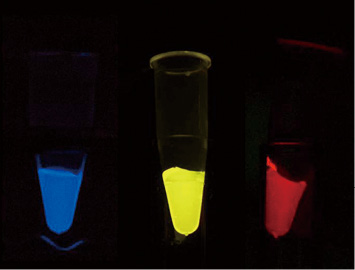
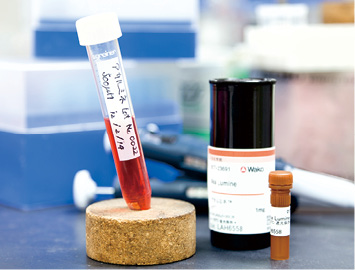
This technology converts long light wavelengths to innovate emission in the three primary RGB colors (red: 675 nm; green: 560 nm; blue: 450 nm). We have also developed a way to change the wavelength in steps of 30 nm and a technology for enhancing luminescent activity.
In our studies of a precious metal reduction catalyst, we developed a polymer-supported palladium hydrogenation catalyst, a radically novel catalyst that grants control selectivity in hydrogenation reactions. The adoption of the polymer, which supports the palladium metal on its surface, facilitates catalytic reactions and even enables continuous reactions, thereby enabling high selectivity in hydrogenolysis-free hydrogenation reactions or pinpoint hydrogenation reactions in which the number of substitutions can be selected.
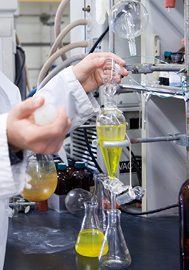
Remaining true to our philosophy-to generate leading technologies in leading-edge fields-we strive to innovate new technologies based on our extensive knowledge and original ideas.
Before Aka Lumine®, it was generally believed that 630 nm represented the upper limit for the luminescence wavelength of a luminescent substance innovated using the commonly-employed method of making structural alterations in enzymes. Assistant Professor Maki conceived the idea of achieving longer wavelengths by targeting the substrate, on which the enzyme acts, rather than the enzyme. However, work shows that the slightest alteration in the substrate resulted in a loss of luminescent properties. Another discovery was the essential role of the anion structure in the aromatic ring in luminance; this imposed restrictions on the degree of freedom possible in luciferin alterations.
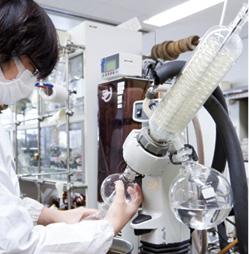

Drawing on an extensive pharmaceutical background, Assistant Professor Maki then came up with the idea of applying the method of structure-activity relationship (SAR) common in pharmaceutical development. In the SAR method of organic synthesis, large numbers of compounds with slightly altered structures are produced and each examined to assess properties to correlate specific parts of a structure to specific activities. Using this method, Assistant Professor Maki designed the chemical structure responsible for determining the color of luminescence. He discovered that the presence/lack of a single double bond in the luciferin, together with the non-anionic structure of the aromatic ring, resulted in a 100-nm, 30nm difference in wavelength. This discovery led to the production of technologies for RGB three primary color emission using artificial luciferin inspired by the firefly’s bioluminescence system, a feat widely regarded as a major challenge. The discovery also resulted in the world’s longest luminescence wavelength, 675 nm.
The polymer-supported palladium hydrogenation catalyst is the hopes of Assistant Professor Maki, a specialist in organic synthesis. Complex compounds normally have numerous double bonds. Conventional catalysts are incapable of reducing a specific double bond singled out as the target of interest by the researcher. Assistant Professor Maki believed selective reduction could be achieved by developing a totally new preparation method for the catalyst. He conceived the idea of saturating a cotton-like material with metal solution to make a polymer to support the metal catalyst.
This method offers significant potential for practical applications and the following advantages: (1) It enables hydrogenolysis-free hydrogenation reactions of olefin; (2) it enables pinpoint hydrogenation reactions in which the number of substitutions can be selected; (3) it allows the reuse of catalyst, reducing the volume of catalyst required and facilitating recovery and recycling (the 3 Rs of conservation); (4) it offers low ignitability and high safety; (5) it offers durability; (6) it enables mass production; and (7) it achieves low cost.
The achievement was honored with the Incentive Award in Organic electron transfer Chemistry in 2005 and the best teacher award by the University of Electro-Communications in 2011.
Another laboratory policy is to innovate technologies that are in demand, user-friendly and useful. We are active in joint research projects that involve companies and researchers, in this way maintaining a valuable dialogue with actual engineers and scientists to innovate products and making it possible to develop technologies that will benefit them.
In 2011, the “Aka Lumine®” bio-imaging probe modeled on firefly bioluminescence and featuring the world’s longest luminescence wavelength (675 nm) was commercial introduced by Wako Pure Chemical Industries, with technical assistance from Kurogane Kasei Co., Ltd. Aka Lumine® has a wide range of applications in the advanced life sciences and is ideal for advanced oncology, regenerative medicine, and other areas of medical technology. This imaging probe will allow researchers to perform continuous in vivo imaging of tumor tissue and cells deep within the body free of invasive procedures. It will significantly improve the efficiency of laboratory animal studies.
With growing expectations for regenerative medicine in Japan and based on technological development studies of iPS cells, we plan to promote Aka Lumine®, introduced as a commercial product with support from the University of Electro-Communications, to pave the way to elucidating the processes involved in carcinogenesis, tumor growth, and metastasis, thereby helping Japan become a world leader in the field of oncology. To achieve this goal, we hope to innovate multi-color luciferin offering even higher performance (higher luminous intensity and sensitivity) and the associated devices and materials need for effective bio-imaging.
